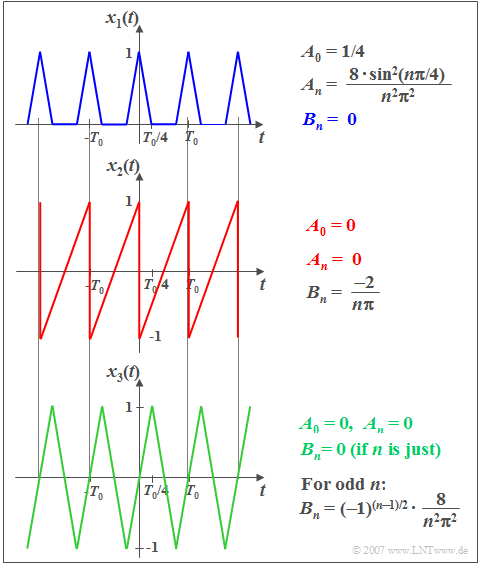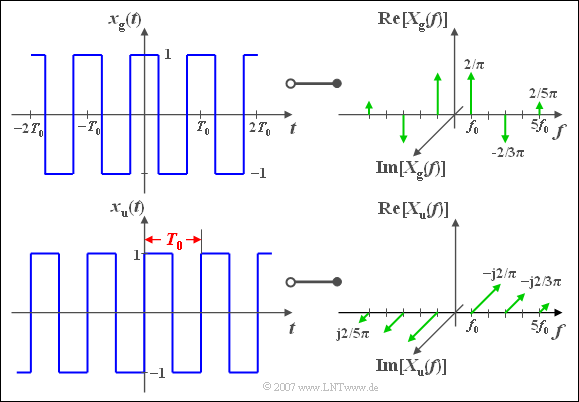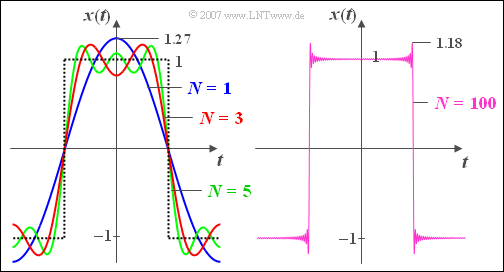Difference between revisions of "Signal Representation/Fourier Series"
| Line 278: | Line 278: | ||
[[Aufgaben:Exercise_2.4Z:_Triangular_Function|Exercise 2.4Z: Triangular Function]] | [[Aufgaben:Exercise_2.4Z:_Triangular_Function|Exercise 2.4Z: Triangular Function]] | ||
| − | [[Aufgaben: | + | [[Aufgaben:Exercise_2.5:_Half-Wave_Rectification|Exercise 2.5: Half-Wave Rectification]] |
| − | [[Aufgaben: | + | [[Aufgaben:Exercise_2.5Z:_Square_Wave|Exercise 2.5Z: Square Wave]] |
| − | [[Aufgaben: | + | [[Aufgaben:Exercise_2.6:_Complex_Fourier_Series|Exercise 2.6: Complex Fourier Series]] |
| − | [[Aufgaben: | + | [[Aufgaben:Exercise_2.6Z:_Magnitude_and_Phase|Exercise 2.6Z: Magnitude and Phase]] |
Revision as of 16:22, 2 November 2020
Contents
General Description
Every periodic function $x(t)$ can be fragmented into a trigonometric series, which is called Fourier series, in all areas, where it is continuous or has only finite discontinuities.
$\text{Definition:}$ The Fourier series of a periodic signal $x(t)$ is defined as follows
- $$x(t) =A_0+\sum^{\infty}_{n=1}A_{\it n} \cdot\cos(n \omega_0 t)+\sum^{\infty}_{n=1} B_n \cdot \sin(n \omega_0 t).$$
Here the symbols denote the following definitions:
- $A_0$ the constant component of $x(t)$,
- $A_n$ the cosine coefficients with $n \ge 1$,
- $B_n$ the sine coefficients mit $n \ge 1$,
- $\omega_0 = 2\pi/T_0$ the angular frequency of the periodic signal $(T_0$ is the period duration$)$.
If the Fourier series is to exactly match the actual periodic signal $x(t)$ , an infinite number of cosine and sine coefficients must generally be used for calculation.
- If the Fourier series is interrupted and only $N$ of $A_n$ and $B_n$ coefficients is used, then a slightly different plot of the function results except for some special cases:
- $$x_ N(t) =A_0+\sum^N_{n=1}A_ n \cdot \cos(n \omega_0 t)+\sum^N_{n=1} B_{n} \cdot \sin(n \omega_0 t).$$
- The relation between the periodic signal $x(t)$ and the Fourier series approximation $x_N(t)$ holds:
- $$x(t)=\lim_{N\to \infty} x_{N}(t).$$
- If $N \cdot f_0$ is the highest frequency occurring in the signal $x(t)$ then of course $x_N(t) = x(t)$.
$\text{Example 1:}$ We consider two periodic square wave signals, each with the period duration $T_0$ and the fundamental frequency $\omega_0 = 2\pi/T_0$.
- For the even time signal sketched above: $x_{\rm g}(-t) = x_{\rm g}(t)$.
- The function shown below is odd: $x_{\rm u}(-t) = -x_{\rm u}(t)$.
One finds the fourier series representations of both signals in formularies:
- $$x_{\rm g}(t)=\frac{4}{\pi}\left [ \cos(\omega_0 t)-\frac{1}{3}\cdot \cos(3 \omega_0 t)+\frac{1}{5}\cdot\cos(5 \omega_0 t)- \hspace{0.05cm}\text{...}\hspace{0.05cm} + \hspace{0.05cm}\text{...}\hspace{0.05cm}\right ],$$
- $$x_{\rm u}(t)=\frac{4}{\pi}\left [ \sin(\omega_0 t)+\frac{1}{3}\cdot\sin(3 \omega_0 t)+\frac{1}{5}\cdot\sin(5 \omega_0 t)+ \hspace{0.05cm}\text{...}\hspace{0.05cm} + \hspace{0.05cm}\text{...}\hspace{0.05cm} \right ].$$
- Because of the generally valid relationship
- $$1-\frac{1}{3}+\frac{1}{5}-\frac{1}{7}+\frac{1}{9}\, {-}\, \hspace{0.05cm}\text{...}\hspace{0.05cm} \, {+} \hspace{0.05cm}\text{...}\hspace{0.05cm}=\frac{\pi}{4}$$
the amplitudes (maximum values) of the two rectangle pulses result to $1$.
- This can also be verified using the signal curves in the above graphic:
- $$x_{\rm g}(t = 0) = x_{\rm u}(t = T_0/4) = 1.$$
Calculation of the Fourier Coefficients
The Fourier coefficient $A_0$ specifies the constant component which can be determined by averaging over the signal course $x(t)$ . Due to the periodicity, averaging over one period is sufficient:
- $$A_0=\frac{1}{T_0}\cdot \int^{+T_0/2}_{-T_0/2}x(t)\,{\rm d}t.$$
The integration limits can also be selected from $t = 0$ to $t = T_0$ (or over a differently defined period of equal length).
The determination of the Fourier coefficients $A_n$ and $B_n$ $(n \ge 1)$ is based on the property that the harmonic cosine functions and sine functions are so-called orthogonal functions . For them the following applies:
- $$\int^{+T_0/2}_{-T_0/2}\cos(n \omega_0 t)\cdot\cos(m \omega_0 t)\,{\rm d}t=\left \{{T_0/2\atop 0}{\rm\quad if \it \quad m=n,\atop \rm sonst} \right.$$
- $$\int ^{+T_0/2}_{-T_0/2}\sin(n\omega_0 t)\cdot\sin(m \omega_0 t)\,{\rm d}t=\left \{{T_0/2\atop 0}{\rm\quad if \it \quad m=n,\atop \rm sonst} \right.$$
- $$\int ^{+T_0/2}_{-T_0/2}\cos(n \omega_0 t)\cdot\sin(m \omega_0 t)\,{\rm d}t=0 \quad \rm f\ddot{u}r\quad alle \ \it m, \ n.$$
$\text{Conclusion:}$ Considering these equations, the cosine coefficients $A_n$ and the sine coefficients $B_n$ result as follows
- $$A_{\it n}=\frac{2}{T_0}\cdot \int^{+T_0/2}_{-T_0/2}x(t)\cdot\cos(n \omega_0 t)\,{\rm d}t,$$
- $$B_{\it n}=\frac{2}{T_0}\cdot \int^{+T_0/2}_{-T_0/2}x(t)\cdot\sin(n \omega_0 t)\,{\rm d}t.$$
The german learning video Calculating the Fourier Coefficients illustrates these equations.
$\text{Example 2:}$ We consider the drawn periodic time function
- $$x(t)=0.4+0.6\cdot \cos(\omega_0 t)-0.3\cdot\sin(3 \omega_0 t).$$
Since the integral of the cosine and sine functions is identical to zero over one period in each case, one obtains for the DC signal coefficient $A_0 = 0.4$.
One determines the cosine coefficient $A_1$ with the following equations $($Integration limits from $t = 0$ to $t = T_0)$:
- $$ \begin{align*} A_{1}=\frac{2}{T_0}\cdot \int^{T_0}_{0}\hspace{-0.3cm}0.4\cdot\cos(\omega_0 t)\,{\rm d}t + \frac{2}{T_0}\cdot \int^{T_0}_{0}\hspace{-0.3cm}0.6\cdot\cos^2(\omega_0 t)\,{\rm d}t - \frac{2}{T_0}\cdot \int^{T_0}_{0}\hspace{-0.3cm}0.3\cdot\sin(3 \omega_0 t)\cdot \cos(\omega_0 t)\,{\rm d}t.\end{align*} $$
The last integral is equal to zero due to orthogonality; the first one is zero too (integral over one period).
- Only the middle term contributes here to $A_1$, namely $2 - 0.6 - 0.5 = 0.6. $
- For all further ($n \ge 2$) cosine coefficients all three integrals return the value zero, and thus $A_{n \hspace{0.05cm}\neq \hspace{0.05cm}1}=0$.
To determine the sine coefficients $B_n$ with the determining equation:
- $$ \begin{align*} B_{\it n}=\frac{2}{T_0}\cdot \int^{T_0}_{0}\hspace{-0.3cm}0.4 \cdot \sin(n \ \omega_0 t)\,{\rm d}t + \frac{2}{T_0} \cdot \int^{T_0}_{0}\hspace{-0.3cm}0.6\cdot \cos(\omega_0 t) \sin(n \omega_0 t)\,{\rm d}t - \frac{2}{T_0}\cdot \int^{T_0}_{0}\hspace{-0.3cm}0.3\cdot \sin(3 \omega_0 t) \sin(n \omega_0 t )\,{\rm d}t. \end{align*} $$
- For $n \hspace{0.05cm}\neq \hspace{0.05cm}3$ all three integral values are zero and therefore $B_{n \hspace{0.05cm}\neq \hspace{0.05cm}3} = 0.$
- On the other hand, for $n=3$ the last integral provides a contribution, and one gets for the sine coefficient $B_3 = -0.3.$
Exploitation of Symmetries
Some insights into the Fourier coefficients $A_n$ and $B_n$ can already be read from the Symmetry properties of the time function $x(t)$ .
- If the time signal $x(t)$ is an even function ⇒ axis-symmetrical around the ordinate $(t = 0)$, all sine coefficients $B_n$ disappear, since the sine function itself is an odd function ⇒ $\sin(-\alpha) = -\sin(\alpha)$:
- $$B_n = 0 \hspace{0.4cm}(n = 1, \ 2, \ 3, \text{...}).$$
- An odd function $x(t)$ is point symmetric around the coordinate origin $(t= 0; \ x =0)$. Therefore, all cosine coefficients $(A_n = 0)$ disappear here, since the cosine function itself is even. In this case, the constant component $A_0$ is also always zero.
- $$A_n = 0 \hspace{0.4cm}(n = 0, \ 1, \ 2, \ 3, \text{...}).$$
- If a function without a constant component is present $(A_0 = 0)$ and if this function is odd within a period ⇒ it is $x(t) = -x(t - T_0/2)$, then only odd multiples of the fundamental frequency are present in the Fourier series representation. For the coefficients with an even index, however, the following always applies:
- $$A_n = B_n = 0 \hspace{0.4cm}(n = 2, \ 4, \ 6, \text{...}).$$
- If all coefficients $A_n$ and $B_n$ with even-numbered index $(n = 2, \ 4, \ 6, \text{...})$ equals zero and the coefficient $A_0 \neq 0$, then the symmetry property mentioned in the last point refers to the DC component and applies:
- $$x(t) = 2 \cdot A_0 - x (t - T_0/2).$$
Remark: Several of the named symmetry properties can be fulfilled at the same time.
The symmetry properties of the Fourier coefficients are explained in the first part of the german learning video Properties and Accuracy of the fourier series .
$\text{Example 3:}$ The above mentioned properties are now illustrated by three signal characteristics.
- $x_1(t)$ is an averaged function ⇒ $A_0 \ne 0$ and is also even, which is accordingly exclusively determined by cosine coefficients $A_n$ $(B_n = 0)$.
- In contrast, the odd function $x_2(t)$ all $A_n, \ ( n \ge 0)$ are identical to zero.
- Also the odd function $x_3(t)$ contains only sine coefficients, but because of $x_3(t) = -x_3(t - T_0/2)$ exclusively for odd values of $n$.
Complex Fourier Series
As shown on the page 3 Representation with Cosine and Sine Components in case of a harmonic oscillation any periodic signal
- $$x(t) =A_0+\sum^{\infty}_{n=1}A_{\it n} \cdot\cos(n \omega_0 t)+\sum^{\infty}_{n=1} B_n \cdot \sin(n \omega_0 t)$$
can also be displayed using the magnitude and phase coefficients:
- $$x(t) =C_0+\sum^{\infty}_{n=1}C_{\it n} \cdot\cos(n \omega_0 t-\varphi_n).$$
These modified Fourier coefficients have the following properties:
- The DC coefficient $C_0$ is identical with $A_0$.
- The magnitude coefficient read with $n\ge 1$: $C_n = \sqrt{A_n^2 + B_n^2}$.
- For the phase coefficient applies: $\varphi_n = \arctan \hspace{0.05cm}(B_n/A_n$).
With the „Eulerian relationship” $\cos(x) + {\rm j} \cdot \sin(x) = {\rm e}^{{\rm j} \hspace{0.05cm}x}$ we get a second representation variant of the Fourier series evolution, which starts from the complex exponential function.
$\text{Definition:}$ The complex Fourier series of a periodic signal x(t) is as follows
- $$x(t)=\sum^{+\infty}_{ n=- \infty}D_n\cdot {\rm e}^{ {\rm j} \hspace{0.05cm} n \hspace{0.05cm}\omega_0\hspace{0.05cm} t}.$$
Here $D_n$ denote the complex Fourier coefficients, which
- from the cosine coefficients $A_n$ and the sine coefficients $B_n$, or
- from the magnitude coefficients $C_n$ and the phase coefficients $\varphi_n$
can be calculated as follows $($valid for $n \neq 0)$:
- $$D_n = 1/2\cdot (A_n - {\rm j}\cdot B_n) =1/2\cdot C_n\cdot {\rm e}^{- {\rm j} \hspace{0.05cm} \varphi_n }$$
The complex Fourier coefficients can also be calculated directly using the following equation
- $$D_n=\frac{1}{T_0}\cdot \int^{+T_0/2}_{-T_0/2}x(t) \cdot{\rm e}^{-\rm j \hspace{0.05cm}\it n \hspace{0.1cm}\omega_{\rm 0} \hspace{0.05cm}t}\, {\rm d}t.$$
As long as the integration interval $T_0$ is preserved, it can be shifted randomly as with the coefficients $A_n$ and $B_n$ for example from $t = 0$ to $t = T_0$.
$\text{Conclusion:}$ The coefficient $D_0 = A_0$ is always real. For the complex coefficients with negative iterating index $(n < 0)$ applies:
- $$D_{- n}=D_n^{\hspace{0.05cm}\star} =1/2 \cdot (A_n+ {\rm j}\cdot B_n).$$
Periodic Signal Spectrum
Starting from the complex Fourier series just derived
- $$x(t)=\sum^{+\infty}_{n=-\infty}D_{\it n}\cdot \rm e^{j \it n \omega_{\rm 0} t}$$
and the Displacement Theorem (for the frequency domain) one gets the following spectrum for the periodic signal $x(t)$:
- $$X(f)=\sum^{+\infty}_{n=-\infty}D_n\cdot\delta(f-n\cdot f_0).$$
This means:
- The spectrum of a signal periodic with $T_0$ is a line spectrum for integer multiples of the fundamental frequency $f_0 = 1/T_0$.
- The constant component returns a dirac function at $f=0$ with the impulse weight $A_0$.
- There are also dirac functions $\delta(f \pm n \cdot f_0)$ at the multiples of $f_0$, whereas $\delta(f - n \cdot f_0)$ denotes a dirac function at $f= n \cdot f_0$ (namely in the nonnegative frequency domain) and $\delta(f + n \cdot f_0)$ denotes a dirac at the frequency $f= -n \cdot f_0$ (n the negative frequency domain).
- The pulse weights are generally complex.
Diese Aussagen werden nun anhand zweier Beispiele verdeutlicht.
$\text{Example 4:}$ We consider - as in $\text{Example 1}$ at the beginning of this section - two periodic square wave signals, each with period duration $T_0$ and fundamental frequency $f_0=1/T_0$. The upper signal
- $$x_{\rm g}(t)={4}/{\pi} \cdot \big[\cos(\omega_0 t) - {1}/{3} \cdot \cos(3\omega_0 t)+{1}/{5}\cdot \cos(5\omega_0 t) - \, \text{...} \, + \, \text{...} \big]$$
is a even function, composed of different cosine parts. The corresponding spectral function $X_{\rm g}(f)$ is thus purely real.
Reason: As already described on the page Spectral Representation of a Cosine Signal The fundamental wave returns two Dirac functions at $\pm f_0$, each weighted with $2/\pi$.
- This weighting corresponds to the (generally complex) Fourier coefficients $D_1 = D_{ - 1}^\ast$, which are only real in the special case of an even function.
- Other dirac functions are available in $\pm 3f_0$ (negative), $\pm 5f_0$ (positive), $\pm 7f_0$ (negative) etc.
- All phase values $\varphi_n$ are either zero or $\pi$ due to the alternating signs.
The function $x_{\rm u}(t)$ shown below is odd:
- $$x_{\rm u}(t)={4}/{\pi} \cdot \big[\sin(\omega_0 t)+{1}/{3} \cdot \sin(3\omega_0 t)+{1}/{5} \cdot \sin(5\omega_0 t)+ \, \text{...}\big].$$
Reason: As already described in the $\text{Example 4}$ on the page General Spectral Representation the fundamental wave provides two Dirac functions at $+f_0$ $($weighted with $-\text{j}\cdot 2/\pi)$ bzw. bei $-f_0$ $($weighted with $+\text{j}\cdot 2/\pi)$.
- All other Dirac functions at $\pm 3f_0$, $\pm 5f_0$, etc. are purely imaginary and are located in the same direction as the Dirac functions at $\pm f_0$.
- The two magnitude spectra are equal: $\vert X_{\rm u}(f)\vert = \vert X_{\rm g}(f) \vert$.
The Gibbs Phenomenon
Not every signal is suitable for the fourier series.Some restrictions below:
- An important condition for the convergence of the Fourier series is that the signal may only have a finite number of discontinuities per period.
- At those places $t=t_i$, where $x(t)$ has jumps, the series converges to the arithmetic mean value formed by the respective left and right boundary value.
- In the surrounding area of such discontinuities, high-frequency oscillations usually occur in the row representation. This error is of principle kind, i.e. it could not be avoided too, if infinite summands would be considered. One speaks of Gibbs phenomenon, named after the physicist Josiah Willard Gibbs.
- An increase of $N$ reduces the erroneous range but not the maximum deviation between $x(t)$ and the Fourier series representation $x_N(t)$. The maximum error is ca. $9\%$ of the jumping amplitude - independent of $N$.
The Gibbs phenomenon and other interesting aspects of comparable effects are presented in the german learning video
Properties of Fourier Series Representations .
$\text{Example 5:}$ The left graphic shows a dotted section of a periodic $\pm 1$ rectangle signal and the corresponding Fourier series representation with $N = 1$ (blue), $N = 3$ (red) and $N = 5$ (green) summands.
- The fundamental wave here has the amplitude value $4/\pi \approx 1.27$.
- Even with $N = 5$ (this means because of $A_2 = A_4 = 0$ three „relevant” summands) the Fourier series still differs significantly from the approximated square wave signal, especially in the area of the edge.
From the right graphic you can see that the flank and the inner area are marked with $N = 100$ but due to the Gibbs phenomenon there are still oscillations around $9\%$ at the jumping point.
- Since the jump amplitudes here are equal to $2$ the maximum values are approximately $1.18$.
- With $N = 1000$ the oscillations would be exactly the same size, but limited to a narrower space and possibly not recognizable with time-discrete representation.
Exercises for the Chapter
Exercise 2.4: Rectified Cosine
Exercise 2.4Z: Triangular Function
Exercise 2.5: Half-Wave Rectification
Exercise 2.6: Complex Fourier Series
Exercise 2.6Z: Magnitude and Phase




